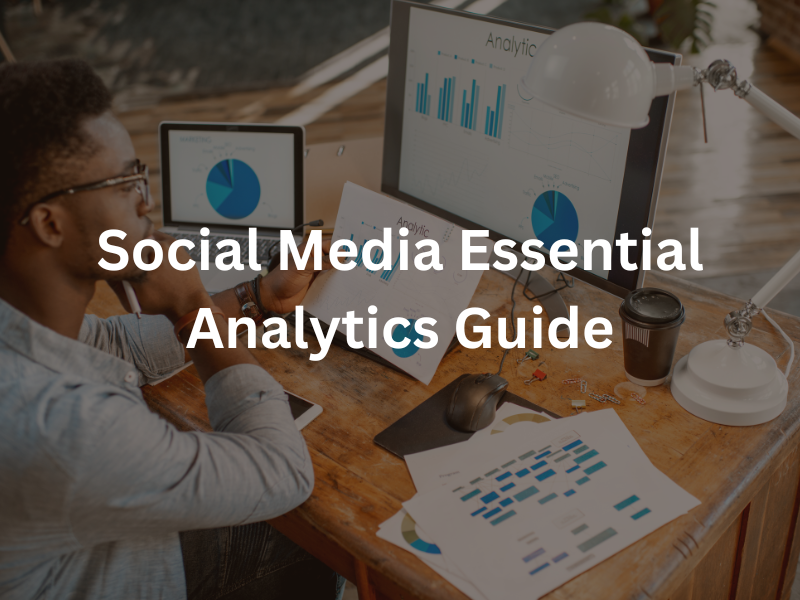In today’s digital landscape, social media has become indispensable to any successful marketing strategy. With billions of active users across various platforms, businesses increasingly leverage social media to connect with their audience, build brand awareness, and drive sales. But how do you know if your social media efforts are paying off? This is where social media performance analysis comes into play.
Social media performance analysis involves collecting, analyzing, and interpreting data from social media channels to measure performance and optimize strategies. It allows businesses to understand what’s working, and what’s not, and how they can improve their social media presence to achieve better results. By diving deep into metrics such as engagement, reach, conversions, and audience growth, companies can gain valuable insights into their audience’s behavior and preferences, ultimately leading to more informed decision-making and improved return on investment (ROI).
This guide aims to provide you with a comprehensive understanding of social media analytics and the tools and techniques you can use to analyze and report on your social media performance effectively. Whether you’re a seasoned marketer or just starting out, this guide will equip you with the knowledge and skills needed to turn data into actionable insights and drive success in your social media campaigns.
1. Understanding Social Media Analytics
What is Social Media Analytics?
Social media analytics is the process of collecting and analyzing data from social media platforms to make informed marketing decisions. This data includes a wide range of metrics, from the number of likes, shares, and comments a post receives to the demographic breakdown of a brand’s followers. By analyzing these metrics, businesses can gain a clear picture of their social media performance, understand audience behavior, and measure the effectiveness of their strategies.
The scope of social media analytics is vast. It extends beyond simply counting likes and retweets to understanding deeper insights such as sentiment analysis, engagement rates, and content performance across different social platforms. Effective social media analytics can provide a holistic view of how a brand is perceived online, helping marketers to craft more personalized and impactful campaigns.
Why is Analytics Important for Social Media Marketing?
Analytics is crucial for social media marketing because it transforms raw data into actionable insights. Here’s why it’s important:
- Enhancing Decision-Making Through Data: With social media analytics, marketers can make data-driven decisions rather than relying on guesswork. This means understanding which content resonates with the audience, what times are most effective for posting, and which platforms generate the most engagement. By analyzing trends and patterns, businesses can refine their social media strategies to better meet their goals.
- Measuring ROI and Optimizing Strategies: One of the biggest challenges in social media marketing is measuring return on investment (ROI). Analytics provides a way to quantify the success of social media efforts by tracking conversions, lead generation, and sales directly attributed to social media activities. This allows marketers to identify high-performing campaigns and allocate resources more effectively.
- Tracking Performance Against Business Goals: Social media analytics helps businesses align their social media activities with their broader marketing objectives. Whether the goal is to increase brand awareness, drive website traffic, or boost sales, analytics can track progress towards these objectives and provide insights on how to achieve them more efficiently.
By understanding the importance of social media analytics, businesses can leverage data to enhance their marketing efforts, ensure a higher ROI, and achieve their social media goals more effectively.
2. Key Social Media Metrics to Track
To truly harness the power of social media analytics, it’s essential to know which metrics to monitor. Not all metrics carry the same weight; some offer more significant insights into your social media performance than others. Understanding these key metrics allows you to focus on what matters most to your business goals and helps you make more informed decisions.
Engagement Metrics
Engagement metrics measure how actively your audience is interacting with your content. These metrics are often considered a strong indicator of how well your content resonates with your audience. Key engagement metrics include:
- Likes and Reactions: The simplest form of engagement, likes and reactions show that a piece of content has caught the viewer’s eye. Though they are a basic measure of engagement, they can still provide insight into what types of content your audience enjoys.
- Shares and Retweets: When someone shares your content, it indicates a higher level of engagement and interest. Shares are especially valuable because they expand your reach beyond your immediate followers and into their networks.
- Comments: Comments reflect a deeper level of engagement, as they show that the audience is not only interested in the content but also wants to participate in the conversation. Monitoring comments can provide valuable qualitative insights into how your audience feels about your brand and products.
- Engagement Rate: This metric represents the percentage of your audience that interacts with your content. A high engagement rate suggests that your content is highly relevant to your audience. It is calculated by dividing the total number of engagements by the total reach or impressions, depending on the platform.
Reach and Impressions
Understanding reach and impressions is crucial for evaluating the visibility of your content.
- Reach: Reach refers to the total number of unique users who have seen your content. This metric is essential for understanding the size of the audience that your content is reaching.
- Impressions: Impressions indicate the total number of times your content has been displayed, regardless of whether it was clicked or not. Unlike reach, impressions can count multiple views by the same user. Tracking impressions helps in assessing how often your content appears in users’ feeds and suggests how visible your posts are.
While both reach and impressions are important, reach provides a better understanding of the potential audience size, while impressions give an idea of content visibility and repetition.
Conversion Metrics
Conversion metrics are directly tied to your business goals, as they measure actions that result in a desired outcome, such as a sale or lead.
- Click-Through Rate (CTR): CTR measures the number of clicks your post or ad receives divided by the number of impressions. It’s an essential metric for understanding how compelling your content is and whether it encourages users to take action.
- Conversions: This metric measures the number of desired actions taken by users after interacting with your content, such as filling out a form, signing up for a newsletter, or making a purchase. Conversions are directly tied to ROI, making them one of the most valuable metrics to track.
- Sales and Revenue: For e-commerce businesses, sales and revenue generated from social media are crucial metrics. They indicate the direct financial impact of your social media marketing efforts.
Audience Growth and Demographics
Tracking audience growth and demographics provides insights into your social media followers and how your audience evolves over time.
- Follower Growth: Monitoring how your follower count changes over time helps assess the overall growth of your social media presence. Sudden spikes or drops in follower count can indicate the success or failure of recent campaigns.
- Audience Demographics: Understanding the demographics of your audience — including age, gender, location, and interests — helps tailor your content to better meet their preferences. This data is invaluable for ensuring that your messaging aligns with your target market.
By focusing on these key metrics, businesses can gain a comprehensive view of their social media performance, allowing for more effective strategy adjustments and more successful marketing campaigns.
3. Top Social Media Analytics Tools
To effectively measure and analyze social media performance, it’s crucial to leverage the right tools. These tools help collect data, generate insights, and create reports that guide strategic decision-making. The market offers a wide variety of social media analytics tools, ranging from free options that provide basic analytics to advanced platforms offering comprehensive, in-depth analysis.
Free Analytics Tools
For those just starting out or looking to monitor social media performance on a budget, free analytics tools are an excellent starting point. These tools are often built into the social media platforms themselves and offer basic metrics that can still provide valuable insights.
- Facebook Insights: This tool provides detailed analytics on page performance, including post reach, engagement, and follower demographics. It helps businesses understand how their content is performing and identify the best times to post.
- Twitter Analytics: Twitter Analytics offers insights into tweet performance, audience demographics, and overall account engagement. It allows users to track key metrics like retweets, mentions, and impressions, helping to optimize tweet strategies.
- Instagram Insights: Available for business profiles, Instagram Insights provides data on follower demographics, post interactions, and stories performance. It helps brands understand which types of content drive the most engagement and reach.
- LinkedIn Analytics: LinkedIn offers analytics for both personal profiles and company pages, focusing on visitor metrics, follower growth, and content engagement. It’s particularly useful for B2B businesses looking to measure the effectiveness of their LinkedIn strategy.
These free tools are highly valuable for basic reporting and performance tracking, allowing businesses to measure key metrics without a financial investment. However, they do have limitations in terms of depth and customization.
Paid Analytics Tools
For those who need more robust analytics and are willing to invest, paid analytics tools provide a wealth of additional features and capabilities. These tools offer more comprehensive data, advanced reporting options, and enhanced customization, which can be crucial for more sophisticated social media strategies.
- Hootsuite: Hootsuite is a popular social media management platform that offers powerful analytics features. It provides detailed reports on social media performance across multiple platforms, including engagement, follower growth, and ROI. Hootsuite’s analytics are customizable, allowing users to create tailored reports that align with their specific needs.
- Sprout Social: Sprout Social is known for its user-friendly interface and comprehensive analytics capabilities. It offers in-depth insights into audience demographics, content performance, and competitive benchmarking. Sprout Social’s advanced reporting features make it easy to track social media metrics over time and demonstrate the impact of social media efforts.
- Buffer: Buffer provides straightforward analytics focused on engagement and reach. It allows users to track the performance of individual posts and campaigns, offering insights into what content works best. Buffer’s simple, clear reports make it easy to quickly understand social media performance.
These paid tools typically come with a subscription fee, but the investment can be well worth it for businesses looking to gain deeper insights and enhance their social media strategies.
Advanced Analytics Platforms
For those seeking the most comprehensive analytics possible, advanced analytics platforms offer deep insights and extensive data integration capabilities. These platforms are designed for larger organizations or those with complex social media strategies who need more powerful tools to analyze and optimize their efforts.
- Google Analytics: While not exclusively a social media tool, Google Analytics is invaluable for tracking social media traffic and conversions on your website. By setting up goals and tracking specific social media campaigns, businesses can measure the effectiveness of their social media efforts in driving website traffic and generating leads or sales.
- HubSpot: HubSpot offers a full suite of marketing tools, including social media analytics. It provides in-depth insights into social media performance, allowing users to track engagement, monitor social media traffic, and measure ROI. HubSpot’s integration with other marketing tools makes it a powerful platform for businesses looking to combine social media analytics with other marketing efforts.
- Brandwatch: Brandwatch specializes in social listening and sentiment analysis, providing detailed insights into how a brand is perceived online. It tracks mentions across various social platforms and the web, helping businesses understand public sentiment and identify trends in real-time.
These advanced platforms offer the most comprehensive analysis and reporting capabilities, making them ideal for businesses that need to dig deeper into their data and gain a more holistic view of their social media performance.
4. Techniques for Effective Social Media Performance Analysis
To truly benefit from social media analytics, it’s not just about the tools you use but also the techniques you apply to analyze the data effectively. By implementing strategic methods, you can maximize the value of your analytics, optimize your social media strategies, and drive better results.
Setting Clear Objectives and KPIs
The foundation of any successful social media strategy is setting clear objectives and key performance indicators (KPIs). Without well-defined goals, it’s challenging to measure success or determine whether your social media efforts are making an impact.
Importance of Defining Goals and KPIs: Establishing specific, measurable, achievable, relevant, and time-bound (SMART) goals is essential for guiding your social media strategy. For instance, if your goal is to increase brand awareness, your KPIs might include reach, impressions, and follower growth. If your objective is to drive sales, you might focus on conversion rates and revenue generated from social media.
Examples of SMART Goals for Social Media:
- Increase Instagram followers by 20% over the next six months.
- Achieve a 5% engagement rate on Facebook posts within the next quarter.
- Generate 100 new leads through LinkedIn ads in the next month.
By setting clear goals and KPIs, you create a roadmap for your social media activities and ensure that your efforts are aligned with your broader business objectives.
Regular Reporting and Monitoring
Consistent reporting and monitoring of your social media performance are crucial for staying on track and making data-driven decisions.
- Best Practices for Creating and Maintaining Reports: Regular reporting allows you to track your progress, identify trends, and adjust your strategies as needed. When creating reports, focus on key metrics that align with your goals and KPIs. Use visuals like graphs and charts to make the data more accessible and easier to understand.
- Frequency of Reporting and What to Include: The frequency of your reports will depend on your specific needs and goals. For some businesses, weekly reports may be sufficient, while others may require daily or monthly updates. A comprehensive report should include a summary of key metrics, insights, and any notable changes or trends.
Regular monitoring also helps in identifying issues or opportunities in real-time, allowing for swift action to optimize performance.
Using A/B Testing to Optimize Campaigns
A/B testing is a powerful technique for optimizing your social media campaigns and understanding what resonates best with your audience.
- Explanation of A/B Testing: A/B testing involves creating two variations of a social media post, ad, or campaign and testing them against each other to see which performs better. By changing one element at a time, such as the image, headline, or call to action, you can determine which version drives more engagement, clicks, or conversions.
- How to Conduct A/B Tests on Social Media: To conduct an A/B test, select a single variable to test, create two versions of the content, and share them with similar audience segments at the same time. Monitor the performance of each version using your analytics tools, and after a sufficient amount of data is collected, analyze the results to identify the winner. Apply the learnings from your tests to future content and campaigns to continuously improve your social media strategy.
Leveraging Sentiment Analysis
Sentiment analysis is an advanced analytics technique that helps you understand how your audience feels about your brand, products, or services based on their social media interactions.
- Understanding Public Sentiment Through Analytics: Sentiment analysis uses natural language processing (NLP) to evaluate the tone and emotion behind social media mentions, comments, and reviews. By analyzing sentiment, you can gauge the overall perception of your brand and identify any potential issues or areas for improvement.
- Tools and Techniques for Sentiment Analysis: Many advanced social media analytics tools, such as Brandwatch and Sprout Social, offer sentiment analysis features. These tools scan social media platforms and categorize mentions as positive, negative, or neutral, providing valuable insights into public opinion. Monitoring sentiment regularly can help you respond promptly to negative feedback, capitalize on positive trends, and refine your messaging and content to better align with your audience’s preferences.
By applying these techniques, you can enhance your social media performance analysis, make data-driven decisions, and achieve better outcomes from your social media marketing efforts.
5. Best Practices for Social Media Reporting
Effective social media reporting is essential for demonstrating the value of your efforts, gaining insights into your performance, and refining your strategies. Well-crafted reports provide a clear picture of what’s working and what isn’t, allowing you to make data-driven decisions and continually improve your social media marketing efforts.
Creating Visual Reports
Visual reports are a powerful way to present data in an engaging and easily digestible format. They help stakeholders quickly grasp key insights without having to wade through dense text or raw data.
- Importance of Visual Data Representation: Visuals such as graphs, charts, and infographics make it easier to understand trends, compare metrics, and identify patterns in social media performance. They can help highlight the success of specific campaigns, illustrate changes in engagement over time, and demonstrate the impact of your social media efforts on broader business goals.
- Tools for Creating Effective Visual Reports: There are numerous tools available that can help you create visually appealing social media reports. Platforms like Canva and Piktochart offer user-friendly templates for building infographics and visual presentations. For more advanced reporting, tools like Power BI and Tableau allow you to create dynamic, interactive dashboards that can be customized to suit your specific needs.
Tailoring Reports to Different Audiences
Understanding your audience is key to creating effective social media reports. Different stakeholders will have different interests and needs, so it’s important to tailor your reports accordingly.
- Customizing Reports for Stakeholders, Clients, and Internal Teams: When reporting to executives or clients, focus on high-level metrics that demonstrate ROI and align with business objectives, such as reach, conversions, and revenue generated. For social media managers or internal teams, dive deeper into metrics like engagement rates, audience growth, and content performance, providing insights that can inform day-to-day strategies and tactics.
- Adapting Language and Detail Level: Adjust the level of detail and the terminology used based on your audience’s familiarity with social media. For example, an executive summary might avoid technical jargon and focus on key takeaways, while a report for the marketing team could include more granular data and analysis.
Actionable Insights and Recommendations
Beyond simply presenting data, an effective social media report should offer actionable insights and recommendations that can guide future strategies.
- How to Derive Actionable Insights from Data: Look for trends and patterns in your data to identify what’s working and what isn’t. For example, if you notice that posts featuring videos consistently outperform text-only posts, you might decide to incorporate more video content into your strategy. Similarly, if engagement rates drop on weekends, you may want to adjust your posting schedule to better align with when your audience is most active.
- Making Data-Driven Decisions to Improve Strategies: Use the insights gained from your reports to refine your social media tactics and improve overall performance. This could involve experimenting with new types of content, adjusting your ad spend, or changing the way you engage with your audience. Regularly reviewing your reports and adjusting your strategy based on the data will help ensure that your social media efforts are as effective as possible.
By following these best practices for social media reporting, you can create compelling, data-driven reports that clearly communicate the value of your social media efforts and provide actionable insights to drive ongoing improvement.
Conclusion
In the ever-evolving landscape of digital marketing, social media analytics is not just a tool but a necessity. By leveraging the right metrics, tools, and techniques, businesses can gain invaluable insights into their social media performance, align their efforts with their business objectives, and drive significant results.
Social media analytics provides a clear window into what resonates with your audience, how your content is performing, and where there are opportunities for improvement. It empowers you to make data-driven decisions, optimize your strategies, and demonstrate the true ROI of your social media activities.
As the digital space continues to grow and change, staying updated with the latest trends in social media analytics will be crucial for maintaining a competitive edge. By implementing the practices outlined in this guide, you’ll be well-equipped to analyze your social media performance effectively, create compelling reports, and continually refine your strategies for success.
Frequently Asked Questions(FAQ)
What is the best free tool for social media analytics?
The best free tool for social media analytics largely depends on the platform you’re focusing on. For instance, Facebook Insights and Instagram Insights are excellent for their respective platforms. Twitter Analytics provides detailed metrics for Twitter, while LinkedIn Analytics is useful for businesses focusing on B2B marketing.
How often should I report on social media performance?
The frequency of reporting should align with your business needs and objectives. Weekly reports are good for tracking short-term performance and making quick adjustments, while monthly reports provide a broader view of trends and overall strategy effectiveness. Quarterly and annual reports are useful for strategic planning and long-term goal setting.
What are some advanced metrics to track beyond basic engagement?
Beyond basic engagement metrics, advanced metrics include sentiment analysis, conversion rates, click-through rates (CTR), social media ROI, customer lifetime value (CLV) from social media, and cost per acquisition (CPA). These metrics offer deeper insights into how social media efforts contribute to broader business goals.
Can social media analytics tools measure ROI accurately?
Yes, many social media analytics tools can measure ROI accurately by tracking conversions, leads, and sales generated from social media campaigns. By setting up proper tracking and integrating with platforms like Google Analytics, you can attribute specific actions to your social media efforts, giving you a clear picture of your ROI.
How can sentiment analysis improve my social media strategy?
Sentiment analysis helps you understand the public perception of your brand, products, or services by analyzing the tone and emotion behind social media interactions. By monitoring sentiment, you can identify potential issues before they escalate, adjust your messaging to better align with audience expectations, and capitalize on positive trends to enhance brand reputation and engagement.













